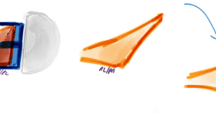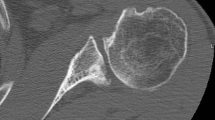Abstract
Background
The PERFORM™ pegged glenoid system has been used for shoulder arthroplasty since 2012. This system offers multiple backside curvatures per size to better match variable patient anatomy. As a result, less reaming is required and subchondral bone is preserved—a critical factor in preventing glenoid migration and loosening, thus enhancing implant longevity.
Purpose
The purpose of this study was to analyze all radiographic modifications around this new glenoid implant.
Method
Thirty-eight shoulders which received the PERFORM™ pegged glenoid component between June 2012 and January 2014 for primary or secondary osteoarthritis were reviewed at two-years minimum follow-up. There were 13 men and 22 women with an average age of 67 years. Humeral components were an uncemented short stem implant in nine (23%) and a resurfacing implant in 29 (77%).
Results
At 27-months average follow-up (24–41), Constant score improved from 30 to 65 points. Range of motion improved significantly at follow-up from 100° to 142° for the anterior elevation, and from 15 to 40° for the external rotation. Radiographic lucent lines (RLL) were observed post-operatively in eight cases (21%), and in 16 cases (42%) at the last follow-up with an increase of the RLL score from 0.36 ± 0.8 to 1.3 ± 2 (p < 0.001) without signs of loosening (RLL > 12). One revision has been performed after anterior shoulder dislocation, rotator cuff tear and glenoid component migration. RLL score was not correlated with dominant side, sex, age, or Constant score.
Discussion-Conclusion
The cemented pegged glenoid component with multiple backside curvatures gave satisfactory results at two-years minimum follow-up for up to three years with a low RLL score. Long-term studies are mandatory to confirm these results.






Similar content being viewed by others
References
Barwood S, Setter KJ, Blaine TA, Bigliani LU (2008) The incidence of early radiolucencies about a pegged glenoid component using cement pressurization. J Shoulder Elb Surg 17:703–708
Choi T, Horodyski M, Struk AM, Sahajpal DT, Wright TW (2013) Incidence of early radiolucent lines after glenoid component insertion for total shoulder arthroplasty: a radiographic study comparing pressurized and unpressurized cementing techniques. J Shoulder Elb Surg 22:403–408
Collin P, Tay AK, Melis B, Boileau P, Walch G (2011) A ten-year radiologic comparison of two-all polyethylene glenoid component designs: a prospective trial. J Shoulder Elb Surg 20:1217–1223
Edwards TB, Labriola JE, Stanley RJ, O'Connor DP, Elkousy HA, Gartsman GM (2010) Radiographic comparison of pegged and keeled glenoid components using modern cementing techniques: a prospective randomized study. J Shoulder Elb Surg 19:251–257
Fox TJ, Cil A, Sperling JW, Sanchez-Sotelo J, Schleck CD, Cofield RH (2009) Survival of the glenoid component in shoulder arthroplasty. J Shoulder Elb Surg 18:859–863
Fox TJ, Foruria AM, Klika BJ, Sperling JW, Schleck CD, Cofield RH (2013) Radiographic survival in total shoulder arthroplasty. J Shoulder Elb Surg 22:1221–1227
Kasten P, Pape G, Raiss P, Bruckner T, Rickert M, Zeifang F, Loew M (2010) Mid-term survivorship analysis of a shoulder replacement with a keeled glenoid and a modern cementing technique. J Bone Joint Surg (Br) 92:387–392
Klepps S, Chiang AS, Miller S, Jiang CY, Hazrati Y, Flatow EL (2005) Incidence of early radiolucent glenoid lines in patients having total shoulder replacements. Clin Orthop Relat Res 435:118–125
Lazarus MD, Jensen KL, Southworth C, Matsen FA 3rd (2002) The radiographic evaluation of keeled and pegged glenoid component insertion. J Bone Joint Surg Am 84-A:1174–1182
Mansat P, Bonnevialle N (2013) Morphology of the normal and arthritic glenoid. Eur J Orthop Surg Traumatol 23:287–299
Mansat P, Briot J, Mansat M, Swider P (2007) Evaluation of the glenoid implant survival using a biomechanical finite element analysis: influence of the implant design, bone properties, and loading location. J Shoulder Elb Surg 16(3 Suppl):S79–S83
McLendon PB, Schoch BS, Sperling JW, Sanchez-Sotelo J, Schleck CD, Cofield RH (2017) Survival of the pegged glenoid component in shoulder arthroplasty: part II. J Shoulder Elb Surg 26:1469–1476
Molé D, Roche O, Riand N, Levigne C, Walch G (1999) Cemented glenoid component: results in osteoarthritis and rheumatoid arthritis. In: Walch G, Boileau P (eds) Shoulder arthroplasty. Springer, New York, pp 163–171
Nyffeler RW, Meyer D, Sheikh R, Koller BJ, Gerber C (2006) The effect of cementing technique on structural fixation of pegged glenoid components in total shoulder arthroplasty. J Shoulder Elb Surg 15:106–111
Rahme H, Mattsson P, Wikblad L, Nowak J, Larsson S (2009) Stability of cemented in-line pegged glenoid compared with keeled glenoid components in total shoulder arthroplasty. J Bone Joint Surg 91A:1965–1972
Roche C, Angibaud L, Flurin PH, Wright T, Zuckerman J (2006) Glenoid loosening in response to dynamic multi-axis eccentric loading. A comparison between keeled and pegged designs with an equivalent radial mismatch. Bull Hosp J Dis 63:88–92
Sabesan VJ, Ackerman J, Sharma V, Baker KC, Kurdziel MD, Wiater JM (2015) Glenohumeral mismatch affects micromotion of cemented glenoid components in total shoulder arthroplasty. J Shoulder Elb Surg 24:814–822
Szabo I, Buscayret F, Edwards TB, Nemoz C, O'Connor DP, Boileau P, Walch G (2005) Radiographic comparison of two glenoid preparation techniques in total shoulder arthroplasty. Clin Orthop Relat Res 431:104–110
Szabo I, Buscayret F, Edwards TB, Nemoz C, Boileau P, Walch G (2005) Radiographic comparison of flat-back and convex-back glenoid components in total shoulder arthroplasty. J Shoulder Elb Surg 14:636–642
Terrier A, Büchler P, Farron A (2005) Bone-cement interface of the glenoid component: stress analysis for varying cement thickness. Clin Biomech 20:710–717
Terrier A, Büchler P, Farron A (2006) Influence of glenohumeral conformity on glenoid stresses after total shoulder arthroplasty. J Shoulder Elb Surg 15:515–520
Throckmorton TW, Zarkadas PC, Sperling JW, Cofield RH (2010) Pegged versus keeled glenoid components in total shoulder arthroplasty. J Shoulder Elb Surg 19:726–733
Torchia ME, Cofield RH, Settergren CR (1997) Total shoulder arthroplasty with the Neer prosthesis: long-term results. J Shoulder Elb Surg 6:495–505
Vavken P, Sadoghi P, von Keudell A, Rosso C, Valderrabano V, Müller AM (2013) Rates of radiolucency and loosening after total shoulder arthroplasty with pegged or keeled glenoid components. J Bone Joint Surg Am 95:215–221
Walch G, Edwards TB, Boulahia A, Boileau P, Mole D, Adeleine P (2002) The influence of glenohumeral prosthetic mismatch on glenoid radiolucent lines. Results of a multicenter study. J Bone Joint Surg Am 84:2186–2191
Walch G, Young AA, Melis B, Gazielly D, Loew M, Boileau P (2011) Results of a convex-back cemented keeled glenoid component in primary osteoarthritis: multicenter study with a follow-up greater than 5 years. J Shoulder Elb Surg 20:385–394
Walch G, Young AA, Boileau P, Loew M, Gazielly D, Molé D (2012) Patterns of loosening of polyethylene keeled glenoid components after shoulder arthroplasty for primary osteoarthritis. J Bone Joint Surg Am 94:145–150
Young AA, Walch G (2010) Fixation of the glenoid component in total shoulder arthroplasty: what is “modern cementing technique?”. J Shoulder Elb Surg 19:1129–1136
Young AA, Walch G, Boileau P, Favard L, Gohlke F, Loew M, Molé D (2011) A multicentre study of the long-term results of using a flat-back polyethylene glenoid component in shoulder replacement for primary osteoarthritis. J Bone Joint Surg (Br) 93:210–216
Author information
Authors and Affiliations
Corresponding author
Ethics declarations
Conflict of interest
The implant manufacturer provided funding for the collection and entry of data.
Rights and permissions
About this article
Cite this article
Dauzère, F., Arboucalot, M., Lebon, J. et al. Evaluation of thirty eight cemented pegged glenoid components with variable backside curvature: two-year minimum follow-up. International Orthopaedics (SICOT) 41, 2353–2360 (2017). https://doi.org/10.1007/s00264-017-3635-7
Received:
Accepted:
Published:
Issue Date:
DOI: https://doi.org/10.1007/s00264-017-3635-7




